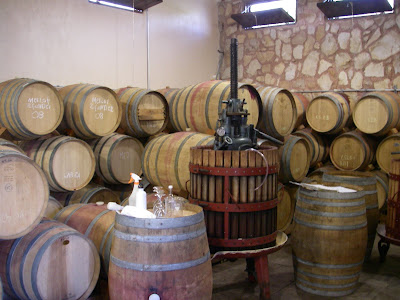I had the chance recently to spend a day in Valle de Guadalupe, about 70 miles south of San Diego. The area has multiple histories of wine-making. First, during the Spanish Colonial period. The second era began in 1903, when some 50 Russian families settled in the area, planting vine stocks that they'd brought with them. These were a later group than those that settled the "Russian" River area of California. But the contemporary wine scene is only about 30 years old. It was a lovely drive, and a very great relief to get beyond the depressing nature of Tijuana.





The choice of Pijoan wasn't quite random. There are more than 30 wineries in the Valle de Guadalupe, including some big operations (Domecq, Cetto, Adobe Guadalupe...) that get visitors by the bus-load - but only on the weekends. However, most are small, open by appointment only. After some research, I had narrowed it down to Casa de Piedras, Mogor Bodan, Vinisterra, and Viñas Pijoan. For whatever reason, my emails to Vinisterra bounced, and I didn't hear back from Piedras or Bodan. Turns out the former is rarely able to take visitors, and Mogor Bodan, the maker of the only Mexican Chasselas, passed away last year. I hear it is very good though, and still available. If only I'd had more time to look for it!
Pau Pijoan is a former veterinarian whose wine hobby got the best of him, and he went full-time only 10 years ago. He is assisted by his lovely wife, Leonora, and daughter Paula - a surfing oceanographer who is into sake! Go on Paula!
Only one winery in the valley is certified organic, but Pijoan still tends towards natural practices - 4 adopted stray dogs roam the vineyards for pests, no herbicides are used, and so on. The wines here are all cuvée, and with the exception of the syrah, the grapes are purchased from vineyards within the valley. So far, Pau feels that his vines aren't yet established enough for what he wants to produce. Fair enough. 


I first got to taste a couple of tank samples, the 2009 Domenica, a Grenache blend augmented by Cabernet Sauvignon and Petite Sirah, and the 2009 Paulinha, a Zinfandel-Merlot blend, also with a touch of Petite Sirah. Have to admit, I don't know the first thing about interpreting tank samples.
On the whole, pleasant wines, and I will keep an eye on their blog - the current top post describes a 6 year vertical tasting-dinner of the Leonora which Paula had described, and which sounded very promising indeed. The wines were pricey though, a problem not unique to Pijoan (I did buy a bottle of the Mare for $25 though, given CA prices this might have been a good value.) Interestingly, this is due primarily to the domestic tax situation, which has made it difficult for these wines to get much awareness abroad. The regional government is also pushing for a D.O. designation, which the winemakers are almost uniformly opposed to, saying it's too much too soon.
Monday, March 1, 2010
Frontiers in Viticulture: Baja California
Subscribe to:
Post Comments (Atom)




No comments:
Post a Comment